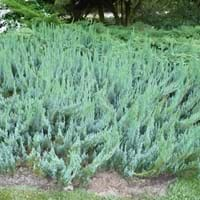Life Span
Perennial
Perennial
Type
Perennial
Needled or Scaled Evergreen
Origin
California
North America
Types
Not Available
Bar Harbour, Andorra Compacta, Blue Forest, Blue Chip, Douglasii, Blue Rug, Glauca, Gold Carpet, Icee Blue, Gold Carpet, J.J. Hughes, Marcellus
Number of Varieties
Not Available
Habitat
Chaparral, River side
Fields, Pastures, Upland soils
USDA Hardiness Zone
7-10
4-9
Sunset Zone
H1, 4, 5, 6, 7, 8, 9, 10, 11, 12, 14, 15, 16, 17, 18, 19, 20, 21, 22, 23, 24
A1, A2, A3, H1, H2, 1a, 1b, 2a, 2b, 3a, 3b, 4, 5, 6, 7, 8, 9, 10, 11, 12, 13, 14, 15, 16, 17, 18, 19, 20, 21, 22, 23, 24
Habit
Upright/Erect
Mat-forming
Minimum Width
Not Available
Flower Color
White, Yellow
Pink, White
Flower Color Modifier
Bicolor
Bicolor
Fruit Color
Green, Tan
Gray, Purple
Leaf Color in Spring
Gray Green
Light Green, Blue Green, Olive, Gray Green, Dark Green, Yellow green
Leaf Color in Summer
Gray Green
Light Green, Blue Green, Olive, Gray Green, Dark Green, Yellow green
Leaf Color in Fall
Gray Green
Light Green, Blue Green, Olive, Gray Green, Dark Green, Yellow green
Leaf Color in Winter
Light Green
Purple, Light Green, Blue Green, Olive, Gray Green, Dark Green, Yellow green
Leaf Shape
Lance shaped
Scale-like imbricate
Plant Season
Spring, Summer
Spring, Summer, Fall, Winter
Sunlight
Full Sun
Full Sun, Partial Sun, Partial shade, Full Shade
Type of Soil
Loam, Sand
Loam, Sand
The pH of Soil
Neutral, Alkaline
Acidic, Neutral, Alkaline
Soil Drainage
Well drained
Average
Bloom Time
Early Spring, Spring, Late Spring, Early Summer, Summer
Not Available
Tolerances
Drought
Drought
Where to Plant?
Ground
Container, Ground
How to Plant?
Cuttings, Seedlings
Hardwood Cuttings, Semi-hardwood cuttings, Softwood cuttings, Stem Cutting
Plant Maintenance
Medium
Medium
Watering Requirements
Needs watering once a week, Water well when planted
Average Water Needs, Do Not over Water, Requires regular watering
In Summer
Lots of watering
Lots of watering
In Spring
Moderate
Moderate
In Winter
Average Water
Average Water
Soil pH
Neutral, Alkaline
Acidic, Neutral, Alkaline
Soil Type
Loam, Sand
Loam, Sand
Soil Drainage Capacity
Well drained
Average
Sun Exposure
Full Sun
Full Sun, Partial Sun, Partial shade, Full Shade
Pruning
prune nearly to the ground in late fall
Remove damaged leaves, Remove dead branches, Remove dead leaves
Fertilizers
organic fertlizers
All-Purpose Liquid Fertilizer
Pests and Diseases
Verticillium Wilt
Tip blight, Twig blight
Plant Tolerance
Drought
Drought
Flowers
Showy
Insignificant
Flower Petal Number
Single
Single
Showy Foliage
Not Available
Yes
Foliage Texture
Not Available
Medium
Foliage Sheen
Not Available
Matte
Attracts
Bees, Birds, Butterflies
Butterflies, Hummingbirds, Wildlife
Allergy
no allergic reactions
Not Available
Aesthetic Uses
Showy Purposes
Decorating walls, Ground Cover, slopes
Beauty Benefits
Not Available
Not Available
Environmental Uses
Air purification
Air purification
Medicinal Uses
antimicrobial, Astringent, Gum Problems, Stomach pain
Diaphoretic, Febrifuge, Kidney problems
Part of Plant Used
Flower Stalk
Leaves
Other Uses
Used as Ornamental plant
Incense
Used As Indoor Plant
No
No
Used As Outdoor Plant
Yes
Yes
Garden Design
Feature Plant, Groundcover, Mixed Border, Wildflower
Container, Edging, Groundcover, Topiary, Bonsai, Espalier
Botanical Name
ROMNEYA coulteri
JUNIPERUS horizontalis
Common Name
Matilija Poppy
Creeping Juniper, Horizontal Juniper
In Hindi
Matilija Poppy
Creeping Juniper
In German
Matilija Poppy
Kriech-Wacholder
In French
Matilija Poppy
Genévrier rampant
In Spanish
Matilija amapola
Creeping Juniper
In Greek
Matilija παπαρούνας
Creeping Juniper
In Portuguese
Matilija Poppy
Creeping Juniper
In Polish
Matilija Poppy
Jałowiec płożący
In Latin
Matilija Poppy
Creeping Juniper
Phylum
Magnoliophyta
Coniferophyta
Class
Magnoliopsida
Pinopsida
Order
Papaverales
Pinales
Family
Papaveraceae
Cupressaceae
Clade
Angiosperms, Eudicots
Not Available
Tribe
Not Available
Not Available
Subfamily
Papaveroideae
Not Available
Number of Species
Not Available
Season and Care of Matilija Poppy and Creeping Juniper
Season and care of Matilija Poppy and Creeping Juniper is important to know. While considering everything about Matilija Poppy and Creeping Juniper Care, growing season is an essential factor. Matilija Poppy season is Spring and Summer and Creeping Juniper season is Spring and Summer. The type of soil for Matilija Poppy is Loam, Sand and for Creeping Juniper is Loam, Sand while the PH of soil for Matilija Poppy is Neutral, Alkaline and for Creeping Juniper is Acidic, Neutral, Alkaline.
Matilija Poppy and Creeping Juniper Physical Information
Matilija Poppy and Creeping Juniper physical information is very important for comparison. Matilija Poppy height is 120.00 cm and width Not Available whereas Creeping Juniper height is 30.00 cm and width 120.00 cm. The color specification of Matilija Poppy and Creeping Juniper are as follows:
Matilija Poppy flower color: White and Yellow
Matilija Poppy leaf color: Gray Green
Creeping Juniper flower color: Pink and White
- Creeping Juniper leaf color: Light Green, Blue Green, Olive, Gray Green, Dark Green and Yellow green
Care of Matilija Poppy and Creeping Juniper
Care of Matilija Poppy and Creeping Juniper include pruning, fertilizers, watering etc. Matilija Poppy pruning is done prune nearly to the ground in late fall and Creeping Juniper pruning is done Remove damaged leaves, Remove dead branches and Remove dead leaves. In summer Matilija Poppy needs Lots of watering and in winter, it needs Average Water. Whereas, in summer Creeping Juniper needs Lots of watering and in winter, it needs Average Water.





